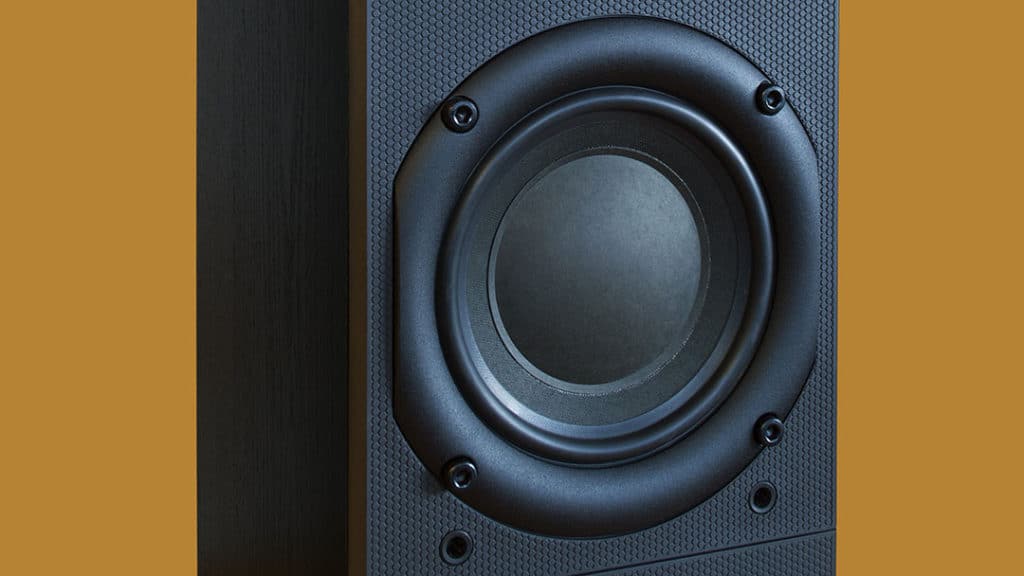Sweet bass, the foundation of musical harmony. Let’s face it; we all have a bit of a bass obsession. Meghan Trainor put it best – it’s all about that bass. You can’t tell me you don’t get the feels when that bass suddenly revs up and pulses through you.
So, clearly, we’ve all experienced some epic bass at concerts and clubs, but those speakers are massive. How can the tiny drivers in headphones produce bass?
It actually comes down to the space in which the music is being played – not the speaker size. In-ear and over-ear closed headphones only need to get the low-frequency sounds from the speaker to your eardrum, and in an enclosed tunnel, it’s easier to produce bass.
This means that headphones and earbuds can produce plenty of bass despite having smaller speakers.
Open-back headphones do let air escape to the back, but because they have bigger drivers and are still close to the ear, they actually produce a bit better bass than other models.
So, in fact, the smaller space in the ear canal and the close proximity to the eardrum makes that a good pair of headphones often produce better bass than most box speakers can. Go headphones!

How Is Bass Produced?
Bass produced by instruments is lower frequency notes that can be heard by the human ear. Sometimes these vibrations can be so low that they are felt rather than heard. That combination creates the perfect bass experience.
There are a number of instruments that can produce bass, but often we think of the electric bass guitar when talking about bass in popular music.
Other instruments that are great for hitting those perfect bass vibrations include the bass drum, tuba, baritone sax, synthesizer, bass saxophone, and sousaphone.
As I mentioned, in essence, bass is vibration. So, how is it produced by these instruments? To simplify things, let’s use the drum as an example. Drums have a large membrane that, when hit, vibrates over the entire surface.
The larger the drum, the slower the vibrations. These vibrations, in turn, compress the surrounding air, sending those sweet bass frequencies like music to your ears.
A bass guitar, on the other hand, has thicker strings than normal guitar strings. This affects how it vibrates once struck, leading to a slower vibration and lower frequencies.
How is bass then replicated by speakers, and how do tiny headphone speakers do it? Well, sound is just a vibration that propagates as an acoustic wave – but there’s one small catch, it needs a medium to travel in.
On earth, sound is only made when air molecules vibrate and move in a wave pattern, i.e., sound waves.
I mention earth for a reason, because you can’t hear anything in space. Space has no air (or molecules that can vibrate), thus no sound.
There’s one more factor to consider; there needs to be a receiving end; in this case, our ears.
So, to get to the answer — box speakers usually have big woofers or bass speakers that work just like a drum, producing slower vibrations and lower frequency sound waves.
Headphone speakers have one advantage; they’re close to the receivers – the ears and the space over which the low frequencies need to move is much less, making it easier to do.
Do Headphones Have Subwoofers?
Headphones don’t have subwoofers, but they can reproduce some pretty good bass. Think of it as a tiny, portable subwoofer that doesn’t require a big amplifier. Because it is enclosed, it does a good job of suppressing vibrations and producing deep bass. The small space in the ear canal also helps.
So, it comes down to this, in a larger space, you actually need larger instruments that can produce stronger sound waves of low frequencies, which can travel through the air to your eardrums.
If you make everything smaller, like imagine eating those magic muffins that Alice did in Wonderland, and suddenly everything gets smaller.
The room (space), and your subwoofers would be teeny tiny. But, they would still produce bass frequencies. That’s basically what’s happening here.
While headphones will probably never sound exactly like a subwoofer, simply because those vibrations can be felt through your entire body, they can honestly stand their ground in the bass department.

Can Earbuds Produce Deep Bass?
Ok, headphones are one thing, but what about their even smaller counterparts, the earbuds. They certainly don’t inspire confidence in their bass producing qualities, but they do have a few things going for them.
Earbuds can actually hit some very low bass frequencies if they have a good quality driver and if the seal around the ear canal is airtight. This makes it possible to get a strong, deep bass, even when compared to bigger headphones. The deeper the speaker goes, the less distortion will occur.
Earbuds have some pretty great engineering, and that makes for some pretty great sound. Who said it’s all about headphone driver size? At the end of the day, it’s all about how you use it.
Earbuds really need good sound isolation to produce good bass (or any sound really). If your earbuds don’t fit well, you’ll get a lot of the sound waves escaping, making anything hard to hear.
That means that, unfortunately, if you want good bass and great sound from earbuds, you really need to invest in a quality pair. Usually, you get what you pay for. Quality brands will have ergonomic designs, great quality materials, and excellent hardware.
A great design is necessary to keep the fit and seal the ear canal, so no sound escapes. If you lose the seal, you lose the bass.
If you already have a set of earbuds, there is a way you can improve the bass your driver can create.
You simply have to improve your seal. You can do this by getting better quality tips for your earbuds and some ear hooks or wings. This will help the earbuds stay in place.
To find your perfect fit, you might need to try a few sizes. No one size fits all as we all have different ears and ear canal sizes. You can get a multi-pack that offers a few sizes, but again, this is where you need to opt for quality. Don’t go for the “lowest price first” filter.
There are also different tip materials to choose from. I personally like foam tips, but if you’re in a warm climate, you might opt for silicone tips.
The design of the tip is also important, and to get great sound isolation, I’d recommend you go for the double or even triple flanges.
These are only recommendations, as this really is all about comfort and personal fit. You have to find what works for you personally.
Just as a personal tip – if you’re specifically looking for earbuds that have great bass, don’t just trust the sales pitch, always read the reviews. Lots of manufacturers can’t really put their money where their mouth is.
In addition, sometimes a driver can deliver a bass, but the distortion might drive you mad. Quality is key.

So, Why Are Subwoofer Loudspeakers so Large?
Great sound is all about the way air is displaced. If you want to displace air in a large space, you need a bigger tool.
Subwoofer loudspeakers need to be so large because they need to displace more air. For a low-frequency sound wave to be produced, the speaker needs to have a large transducer (speaker cone) moving back and forth to create the pressure needed to move our eardrums.
High-frequency sound waves are much easier to produce, and pressure can build up pressure in front of the speaker easily.
The rapid movement of the speaker (as compared to the slower vibrations for lower frequencies) produces shorter sound waves. They can do this in a very short time, making it easier.
The larger the transducer (or speaker cone), the larger the movements, thus they are able to produce louder lower frequencies.
Those longer sound waves can be produced by any speaker, but to get them really loud, you need something bigger.
That’s why most serious sound systems have a dedicated separate subwoofer speaker. They’ll usually have anything from 15 to 21-inch cones and the typical folded horn design. This greatly maximizes their sound production capabilities.
In open-air, it’s a lot more difficult to produce loud low frequencies, and that’s the beauty of headphones and earphones.
They completely eliminate the need to carry sound waves over large open spaces. Delivering great sound directly to your ears.
To get technical, imagine each time the speaker beats like a pulse that’s sent out into space. That’s the rise and fall of the sound wave.
That compressed air vs. decompressed air is the wave. If you imagine a pebble falling into a pond and the subsequent ripples, they get bigger as they reach the end of the pond.
To create the right wave that can ride it all the way to your ear (the end of the pond), you need to apply the right pressure.
Less pressure is needed in your ear canal than in a big room, and that’s why subwoofer speakers are so big.
Bass and Bone Conduction
The curiosity got the better of me, what about bone conduction headphones? How do bone-conduction headphones work, and more importantly, do they produce bass? I mean, they effectively bypass the eardrum, and that’s where low-frequency sound waves are picked up, right? Partly right.
The eardrums aren’t actually good at picking up frequencies below 80 Hz. Your brain can perceive frequencies of as low as 20 Hz, exactly because these frequencies resonate in our bones. With headphones, these frequencies are also picked up by bone. Bone conduction headphones will thus offer some bass.
If you’ve ever felt bass, you know that it resonates through our bones. I think it’s actually pretty cool that our brains actually process these low frequencies differently, and it’s more about feeling it.
Bone Conduction headphones send those vibrations directly to the skull, which activates the brain to process the sounds.
Let’s face it though, bone conduction headphones aren’t for everyone, but I promise you that almost everyone would like to try them at least once… I mean, they’re pretty cool, right?
The fact remains that they actually help people with hearing conditions listen to music, podcasts, and just sound in general. And, for that reason, they’re alright in my books.
Do Bone Conduction Headphones Have Good Bass?
While they won’t quite compare to the overall sound and bass quality of over-ear headphones, they’re not bad either. Bone conduction technology has come a long way, and that means the sound is much clearer than ever before. Bass is all about vibration, and bone conduction is exactly that.
What can you expect in terms of sound quality when it comes to bone conduction headphones? Well, in the past, bone conduction wasn’t as good as it is today, and to give a practical example, imagine screaming with your head under the water in the pool (come on, we all did that as kids… I hope), that muffled sound is your brain hearing through bone conduction.
Now, remember, bone conduction headphones are sending vibrations straight to your skull, no water to travel through.
However, they just aren’t as good as over-ear headphones when comparing apples with apples. Sorry, bone conduction.
As a Final Thought on How Headphones Produce Bass
Headphones produce bass by:
- Producing low-frequency sound waves for a small space
- Only producing sound waves that don’t need to travel far
- Making the most of the small space and compact air.
Bass is all about vibrations, air, and the destination. If the speaker is built for the right vibrations, in the right space, and it’s close to the source, it’s going to deliver.
At the end of the day, if you want great bass and sound quality, opt for over-ear headphones with a quality driver and exceptional design. By keeping the sound in, you’ll really get that great bass you’re looking for.

